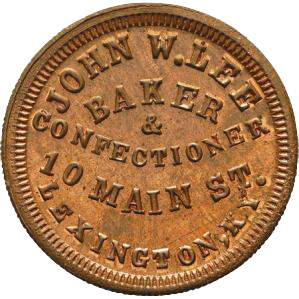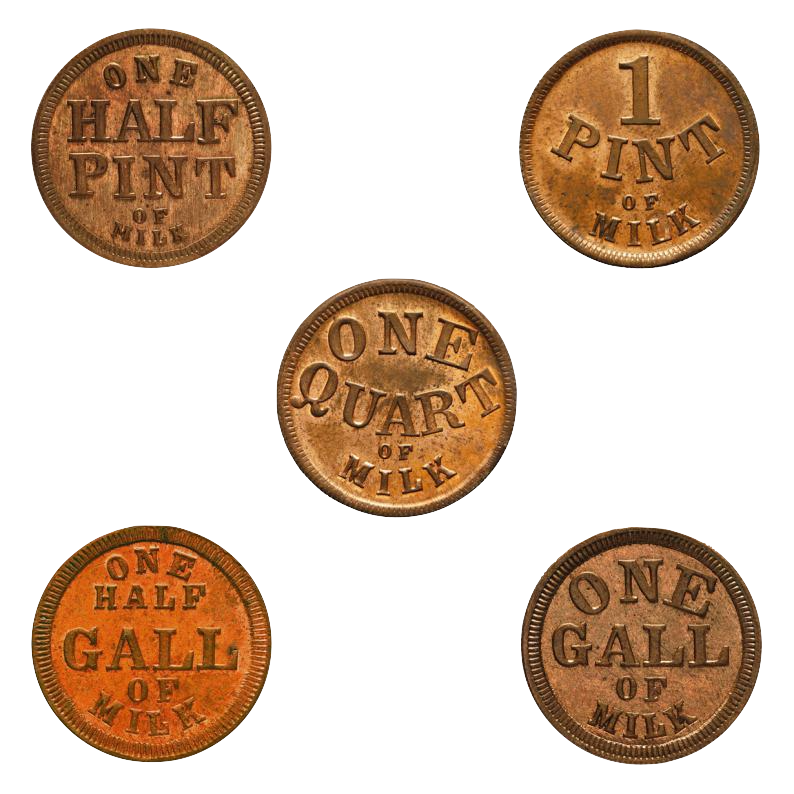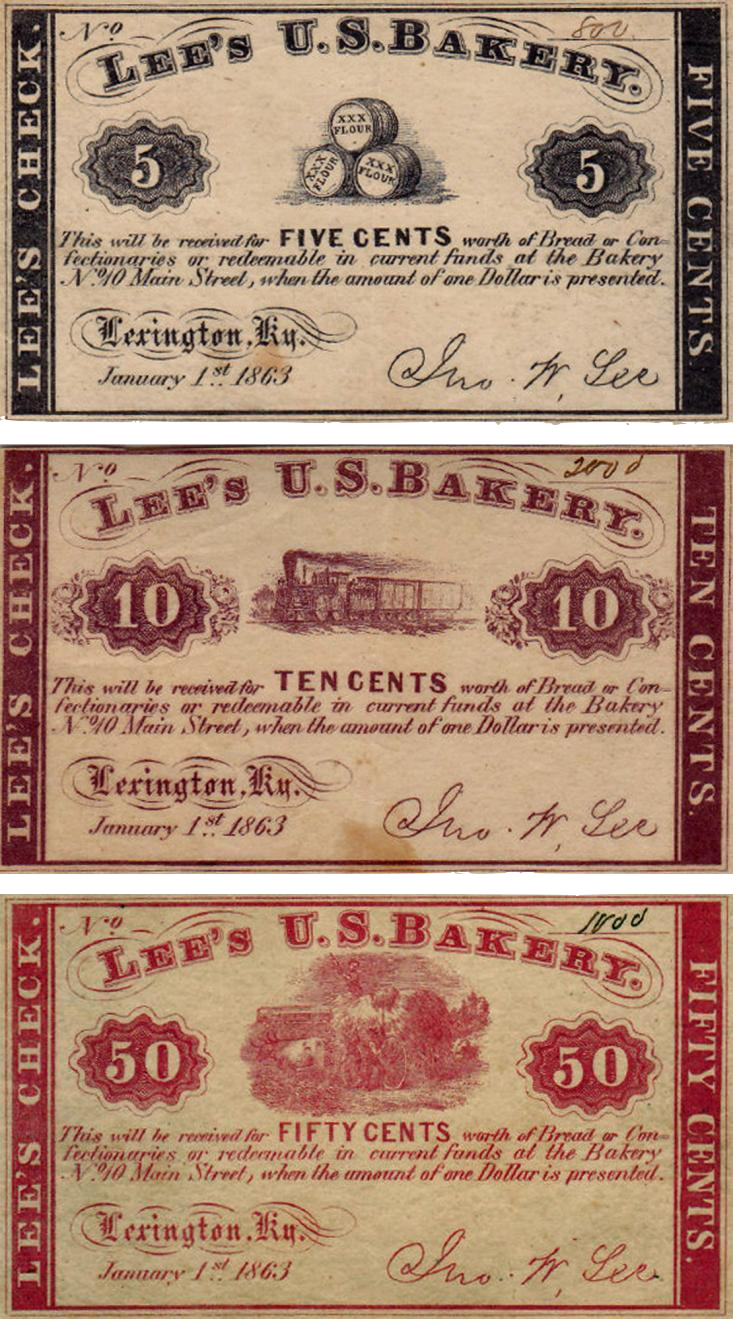CWTS Article of the Month!
Winter 2015
"Slave Owner Issued Civil War Tokens!"
by Donald Erlenkotter
Were there any slave owners who issued Civil War tokens? One’s first thought would be that the answer should be “No” since almost all token issuers were in states in the North, where slavery had been abolished before the war. But what about the border states, where slavery still existed? Could there have been slave owners there who issued tokens?
Here we identify one slave owner who did issue Civil War tokens: John W. Lee of Lexington, Kentucky (KY-480B). Lee’s tokens describe him as a baker and confectioner at 10 Main St., but five of the varieties are milk tokens for quantities of milk ranging from one half-pint up to one gallon.
1 They were struck by the shop of John Stanton of Cincinnati, and the three primary token varieties used Stanton’s Indian head reverse dies 1047, 1068, and 1069.
2

John W. Lee was born in County Cork, Ireland in about 1833. He went from Cincinnati to Lexington in the early 1850s and was employed there as a journeyman baker by William Scott. By 1860 he had established his own bakery and confectionery, and in that year’s census for Lexington he and his family were recorded as follows:
- John W. Lee, age 27, born KY [sic], baker and confectioner, real estate valued at $1,800, personal estate valued at $3,000
- Frances " , age 25, b. KY
- Simeon " , age 9 months, b. KY
|
Seven others are listed in his household, including two bakers and a confectioner.
3
 1047 1068 1069
1047 1068 1069
Indian head store card reverse dies for KY-480B tokens

Store card reverse dies 1463-1467 for John W. Lee’s milk tokens

Civil War scrip checks issued by Lee’s U.S. Bakery, Lexington, Ky., dated January 1st, 1863
The 1860 slave schedule for Lexington, Ward 2, p. 452, lists six slaves for John W. Lee: four males, ages 25, 7, 4, and 1; and two females, ages 35 and 16 years old.
John W. Lee had married Frances Hardesty at Lexington on May 5, 1858.
4 The marriage record gives his birthplace as Ireland. Reportedly this marriage brought considerable means that aided him in establishing his fortune.
5 His wife was the daughter of Henry and Sarah (Dykes) Hardesty of Fayette County.
6 The 1850 slave schedule for Fayette County lists Henry Hardesty as the owner of four slaves. His widow, Sarah Hardesty, appears in the 1860 census for Lexington along with her daughter Judith, age 30, and the accompanying slave schedule indicates that Sarah was the owner of eight slaves.
7
The 1864 directory for Lexington gives the following listing for Lee’s business and residence:
- LEE JOHN W., U. S. Premium Bakery and Confectionery, No. 10 Main Street, res “Eden” Farm nr Railroad
- LEE J. W., Livery and Sale Stables, s e c Mulberry and Short
|
During the war he had a contract to provide baked goods for the U.S. Government, and most likely this is the rationale for the designation of his business as the “U. S. Premium Bakery.” Lee issued a series of paper notes or checks dated January 1, 1863, bearing the identification “Lee’s U.S. Bakery” and his signature. These checks were redeemable in “bread or confectionaries” or in current funds in amounts of $1.
8 His Eden Farm may have been the source of milk distributed to customers by deliverymen who were paid with Lee’s milk tokens.
Although he had been a slave owner, Lee was described as a true and consistent Unionist. He was said to have been amiable in disposition and always tolerant of the opinions of others, even when they were most adverse to his own. But one newspaper called him an extremist in politics. A respondent to this statement wrote:
That means that he did not straddle the fence like the Janus-faced sneaks of Kentucky during the war. . . . for unobtrusively, though firmly, taking the Union side when the matter became a question which no one could dodge, he was plundered by the rebels each time they visited this city [Lexington] in force and his entire bakery establishment reduced to ashes.9
|
Since Lee’s business was still in operation in 1864, it seems probable that it was destroyed in the last Confederate raid on Lexington by General John Hunt Morgan and his men during June 8-10, 1864. In addition to looting the city, the raiders set fire to several buildings and hundreds of cords of wood at the Kentucky Central Railroad building near the Asylum for the Insane.
10 Lee’s farm, which was near the railroad, adjoined the asylum. In the 1867 city directory for Lexington, John W. Lee is listed as a gardener opposite the west end of Second St., where the asylum was located. He was no longer identified as a baker.
After the war, Mr. Lee was a prosperous farmer who had property valued at around $30,000. However, he was disturbed by his inability to get the Government to allow his claims against it. He had difficulty sleeping, his mental condition deteriorated, and he began to fear that he was becoming insane. For several days before his death he was haunted by the thought that he was going to be seized as a lunatic and confined in the neighboring asylum. Early on the morning of February 16, 1869 his sister-in-law Judith Hardesty, who lived in a room upstairs, heard her sister cry out and went below to investigate. The Lees’ bedroom door was locked, but Miss Hardesty was able to get their young son to open it. Inside, both her sister and brother-in-law were dead or dying.
11
There are conflicting accounts about what had happened.
12 All agree that Mr. Lee had committed suicide by cutting his throat with a razor. Some maintain that he had also murdered his wife by cutting her throat, but others say that she was killed inadvertently while attempting to stop her husband from killing himself. Their young son had escaped by hiding under the bed, and it’s not clear if he had also been intended as a victim. The cause given for Mr. Lee’s suicide was his mental deterioration and depression, which may have been due to a form of dementia described at the time by the now-archaic term “softening of the brain.”
Mr. and Mrs. Lee are buried together in the Lexington Cemetery, along with their sons Simeon E. (1859-1860) and John Harry (1861-1867).
13 Their youngest son, Samuel, was living in 1870 with his aunt, Judith Hardesty, in the household of her brother, Henry Hardesty, in Lexington.
14 Samuel Wesley Lee died unmarried in Mariemont, Ohio on March 22, 1943 and is buried in Spring Grove Cemetery, Cincinnati in the lot of his uncle, Rev. Thomas Lee, D.D. His cemetery record says he was born on November 24, 1864 in Lexington.
15
John W. Lee is remembered today for the Civil War tokens and scrip he issued during the war. These items convey little about the turmoil under which he lived and the eventual tragic end of his life. They all are quite rare: the most common of the token varieties are of rarity R-8, with 5 to 10 examples of each believed to survive. One wonders how many were destroyed when his bakery was burned, and how many of those remaining were lost following his unfortunate demise.
Acknowledgment:
I would like to thank David Gladfelter for providing the images of John W. Lee’s scrip checks for his U.S. Bakery.
Notes:
1. Fuld, George and Melvin,
U.S. Civil War Store Cards, Third Edition, The Civil War Token Society, 2014, pp. 36, 38, 58, 187.
2. One variety, KY-480B-8d, with the 1069 reverse die dated 1863, is a numismatic strike of rarity R-10 which resides in the ANS collection.
3.
1860 U.S. Federal Census, Lexington, Fayette County, KY [p. 426, family #1147]. (Earlier census records for Frances (Hardesty) Lee indicate that she was born ca. 1830.)
4.
Kentucky Marriage Records, 1852-1914, Ancestry.com, Provo, UT, 2007 [http://search.ancestry.com/].
5. “Fearful Tragedy in Kentucky,”
Cincinnati Commercial Tribune, Cincinnati, OH, February 19, 1869, p. 6.
6.
1850 U.S. Federal Census, District No. 2, Fayette County, KY [p. 236, family #620].
7.
1860 U.S. Federal Census, Lexington, Fayette County, KY [p. 601, family #1221].
8. “Scrip Mates, Part 2: Kentucky,”
The Civil War Token Journal, Vol. 49, No. 2 (Summer 2015), pp. 8-9.
9. “The Tragic Death of John W. Lee and His Wife in Lexington, Kentucky,”
Cincinnati Commercial Tribune, Cincinnati, Ohio, February 25, 1869, p. 2.
10. “The Civil War in Lexington,”
A National Register of Historic Places Travel Itinerary [http://www.nps.gov/nr/travel/lexington/civilwar.htm].
11. “Terrible Tragedy – A Man Cuts His Wife’s Throat with a Razor and Then Cuts His Own,”
The Courier-Journal, Louisville, Kentucky, February 17, 1869.
12. “Horrible Tragedy in Lexington, Ky.,”
Cincinnati Daily Gazette, Cincinnati, Ohio, February 17, 1869, p. 3; “The Lee Tragedy: A True Account of the Affair,”
Cincinnati Daily Gazette, Cincinnati, Ohio, February 24, 1869, p. 1; “Fearful Tragedy in Kentucky,”
Cincinnati Commercial Tribune, Cincinnati, Ohio February 19, 1869, p. 6; “The Tragic Death of John W. Lee and His Wife in Lexington, Kentucky,”
Cincinnati Commercial Tribune, Cincinnati, Ohio, February 25, 1869, p. 2.
13. The Lexington Cemetery, Lexington, KY [http://www.lexcem.org/index.php/];
Find A Grave [http://www.findagrave.com/].
14. 1870 U.S. Federal Census, Ward 1, Lexington, Fayette County, KY [p. 191, family #506]; Peter, Robert,
History of Fayette County, Kentucky, O. L. Baskin & Co., Chicago, 1882, p. 623.
15. Records of Spring Grove Cemetery, Cincinnati, OH.



 1047 1068 1069
1047 1068 1069

